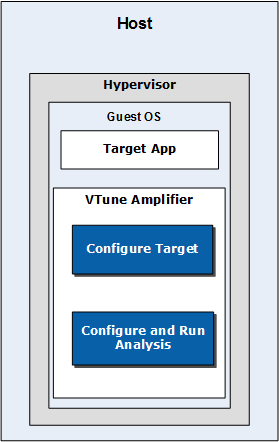Virtual machines are made up of the following components:
Host operating system: system from which the virtual machine is accessed. Supported host systems: Linux*, macOS*, Windows*
Virtual machine manager (VMM): tool used to access and manage the virtual machine. Examples: VMware*, Parallels*
Guest operating system: system accessed via the VMM and profiled using Intel VTune Amplifier. Supported guest systems: Linux*, Windows*
In most cases, Intel VTune Amplifier is installed on the guest operating system and analysis is run on the guest system. The guest system may not have full access to the system hardware to collect performance data. Analysis types that require access to system hardware, such as those that require precise event counters, will not work on a virtual machine.
Note
Typically the host operating system has access to the system hardware to collect performance data, but there are cases in which the host system may also be virtualized. If this is the case and you want to collect performance data on the host system, treat the host system as you would a guest system and assume that it no longer has the same level of access to the system hardware.

Virtual Machine Host/Guest Support
A typical virtualized environment includes a host operating system, which boots first and from which the VMM is loaded, and virtual machines (VMs) running guest operating systems. There are multiple combinations of each and support varies based on each component. For example, the VMM Parallels can be used only with a macOS host system, but can analyze performance with VTune Amplifier installed on either a Linux or Windows guest system.
Linux Host |
Windows Host |
macOS Host |
|
Linux Guest |
KVM XEN Project VMware |
VMware |
Parallels |
Windows Guest |
VMWare |
VMware |
Parallels |
macOS Guest |
-- |
-- |
-- |
Additional steps are required to enable performance analysis on the virtual machine after Intel VTune Amplifier is installed. For more information about installing VTune Amplifier on a virtual machine, see the VTune Amplifier installation guide for your host operating system. Refer to the following topics to enable the vPMU for your hypervisor:
Intel VTune Amplifier Analysis Type Support
Support for VTune Amplifier analysis types varies depending upon which counters have been virtualized by the VMM. If you run an analysis type that cannot be run in a virtualized environment, VTune Amplifier displays a warning message.
In general, the Basic Hotspots analysis type will work on every supported VMM because the analysis type does not require access to the system hardware. The Advanced Hotspots analysis type and other analysis types that use hardware event-based sampling collection have limited reporting functionality. For example, it will not include accurate results for stacks or call counts because this data relies on information provided by precise events (uncore). Running analysis types that rely on precise events will return results, but the collected data will be incomplete or distorted. That is, the result may not point to the actual instruction that caused the event, which can be difficult to differentiate from correct events. Refer to the documentation for your VMM to understand which counters have been virtualized.
Full Features
Limited Features
Advanced Hotspots: Stacks, Call Counts, and Loop Trip Counts not supported
General Exploration: Stacks not supported